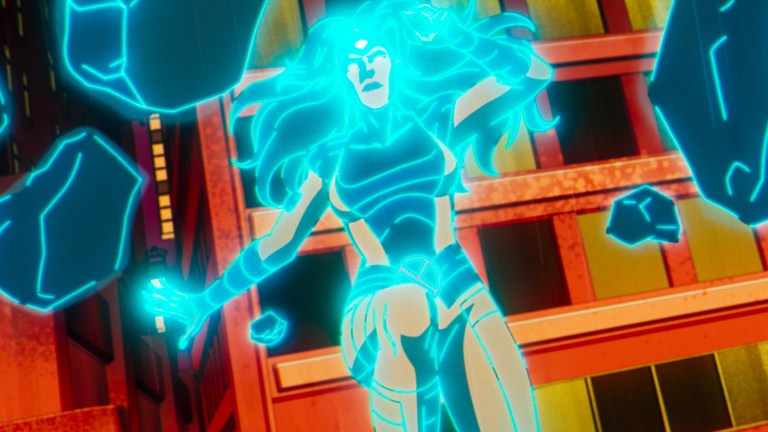X-Men ’97 Episode 7’s Villain Twist Just Set Up One of the Worst X-Men Stories Ever
X-Men '97 just changed the game by introducing its true big bad: Bastion (voiced by Theo James) and the OZT. So what does it all mean for the rest of the season?

This X-Men ’97 article contains spoilers.
Like the original X-Men: The Animated Series before it, X-Men ’97 has been a masterclass in adapting (and updating) classic comic book storylines in ways that make them feel fresh and surprising. The latest episode, “Bright Eyes,” continues this tradition.
“Bright Eyes” deals with the fallout of the destruction of Genosha, with both a beautiful eulogy that Nightcrawler delivers at Gambit’s funeral but also Rogue going, well, rogue to punish those behind Remy’s death. But the biggest reveals involve not just confirmation of Cable’s relationship to Cyclops and Madelyne Pryor, but also that Magneto is still alive and being held hostage by a new villain, one with major ramifications for the rest of this animated universe…
Bastion (Theo James)
X-Men ’97 initially teased Mister Sinister as the big bad of this season. Yet, a new threat has emerged from the shadows in the latest episode, a white haired man dressed in purple called Bastion (voiced here by Theo James).
The mastermind behind Operation: Zero Tolerance, aka OZT, Bastion made his first full appearance in 1996’s Uncanny X-Men #333, written by Scott Lobdell and penciled by Pascual Ferry. Like most X-Men characters, Bastion has an incredibly convoluted backstory.
Bastion came to be when Nimrod, the advanced futuristic Sentinel seen in a few episodes of X-Men: The Animated Series and glimpsed in the opening credits, merged with Master Mold. The X-Men forced the unholy combination through the Siege Perilous (essentially, a magical otherworldly gate), believing that the cosmic forces would judge it harshly.
No such luck. Instead, the combination exited the Siege Perilous in the form of a human, his memory wiped. Taking the name Sebastion Gilberti, he found himself drawn to anti-Mutant organizations. With the help of high-profile players such as Graydon Creed, leader of the Friends of Humanity (last seen in the first episode of X-Men ’97), Bastion secured a powerful place in the U.S. Government.
Over the years, Bastion has been a constant problem for the X-Men. He teamed with the cruel Magus of the Techarchy to unleash the techno-organic virus on his enemies. Working with anti-mutant extremists such as the Purifiers and the Right, Bastion launched a hunt for Hope, the first mutant born after the Scarlet Witch depowered the world’s mutant population. Late in his life, Bastion began developing artificial mutants, a technologically-derived version mixture of mutant and machine.
But Bastion’s most deadly project remains Operation: Zero Tolerance.
Operation: Zero Tolerance
Like most episodes of X-Men ’97, “Bright Eyes” is full of winks and nods to Marvel lore. Members of the Thieves Guild show up for Gambit’s funeral, Strong Guy gets a line, and Captain America and Thunderbolt Ross make cameos. So it would be reasonable for some to assume that “OZT” is just another reference that only the biggest of nerds would get. However, the final moments of “Bright Eyes” suggest a much bigger connection to Operation: Zero Tolerance.
After realizing his true nature as a Sentinel (or, perhaps, after reading the little-loved 1980s DC Comics crossover event Millennium), Bastion channeled his inner Master Mold to create new Sentinels. Unlike their giant purple predecessors, these Prime Sentinels looked like humans and could manifest powers that replicated the X-Gene. But when activated, the Prime Sentinels do what all Sentinels do and neutralize mutants.
During Operation: Zero Tolerance, Bastion took advantage of the vast resources of the U.S. Government to send Prime Sentinels across the world. Worse, Bastion gained access to Xavier’s Mansion and its secret files, giving him access to information about mutant whereabouts and weaknesses. His reign only came to an end when two guys not known for their pro-mutant stances, Henry Peter Gyrich and Senator Robert Kelly, felt Bastion had gone too far and shut down OZT.
How did Bastion gain so much power so quickly you ask? Well, to answer that, we need to drop back a year, to one of the most infamous events in Marvel Comics history.
Onslaught
We all know that Professor X and Magneto are the twin poles of the X-Men universe. But what if they mixed together to become a single bad guy? That’s exactly what happened with Onslaught.
It all began in 1993’s X-Men #25, written by Fabian Nicieza and penciled by Andy Kubert, when Magneto ripped the adamantium skeleton out of Wolverine. The incident was so shocking that people didn’t even wonder why it took so long for Magneto to try that. In fact, it shocked Professor X so much that he used his powers to finally remove all the evil from Mag’s psyche.
As you might suspect, things did not go well from there. And not just because Wolverine ran around without a nose for a while.
Without his dark side, Magneto became a blank slate character called Joseph (we don’t have time to get into all of that). But Xavier didn’t just destroy Magneto’s dark side. Instead, he took it inside of himself.
That dark side welled up inside of Xavier, subtly changing his behavior over a period of 18 months before eventually manifesting in the form of an unstoppable monster called Onslaught, a strange melding of Professor X and Magneto. Onslaught immediately became a problem bigger than the X-Men and, because this was Marvel in the ’90s, led to a company-wide crossover. By the end of the story, Onslaught had killed both the Avengers and the Fantastic Four.
Now, because of Franklin Richard’s ability to warp reality, the Avengers and Fantastic Four were rebooted in the absolutely horrific Heroes Reborn event (source of the heavily-memed drawing of Captain America with distended pecs). That led to another pseudo-reboot called Heroes Return, which was largely excellent.
As for the X-Men, Onslaught’s rampage caused mutants to become even more feared and hated. Which allowed Bastion to gain power and access to Professor X who, wracked with guilt by what Onslaught had done, turned himself in to the authorities.
This short summary doesn’t do justice to the mess that was the Onslaught storyline, of course. Magneto and Xavier have always been mirror images of one another, so there’s a logic to exploring their connections in a single character. But rather than examine the characters, Onslaught made their dark sides into a giant monster who smashes things. The editorial mandate that forced a reboot of the Avengers and the Fantastic Four only further muddies the waters, making Onslaught less an X-Men story about two of its most complex characters and into an indistinct mess.
Obviously, X-Men ’97 isn’t following quite the same trajectory. But “Bright Eyes” ends with Bastion holding Magneto hostage, delivering an unnerving monologue about mutant submission. And Bastion also notes that he’s keeping tabs on Xavier, who is very likely on his way back from Shi’ar space as we speak.
X-Men ’97 has already taken some huge swings, mashing together some of the most devastating X-Men events for a single episode. The arrival of Bastion, a hostage Magneto, and a returning Professor X could very well mean that everything we watched so far is leading to a remixed version of Onslaught. In this version, Bastion could be the reason Professor X and Magneto transform into Onslaught in the first place, the next phase in the villain’s plan to take down mutantkind once and for all.
Is Bastion engineering the birth of Onslaught to gain more power? And does the emergence of Bastion mean that Mister Sinister is now on the sidelines? And will all of this end with Magneto returning to his evil ways?
We don’t know, but we can’t wait to see what unfolds over the last few episodes.
X-Men ’97 is currently streaming on Disney+.
